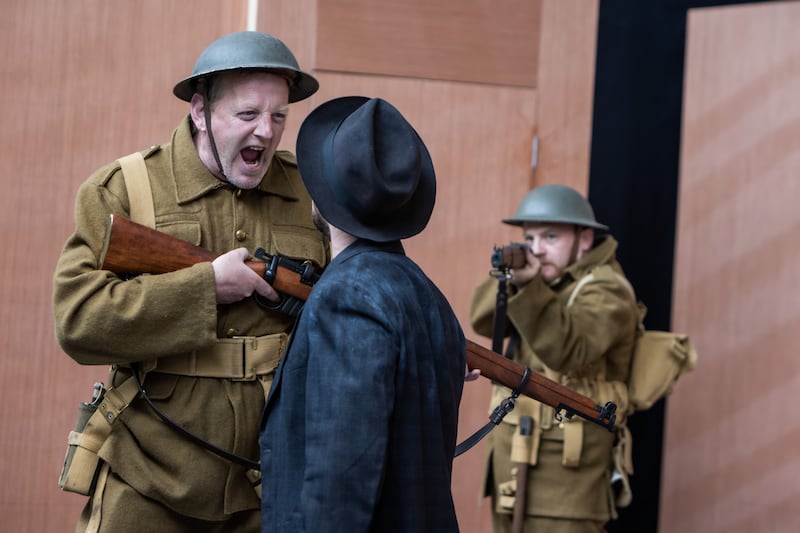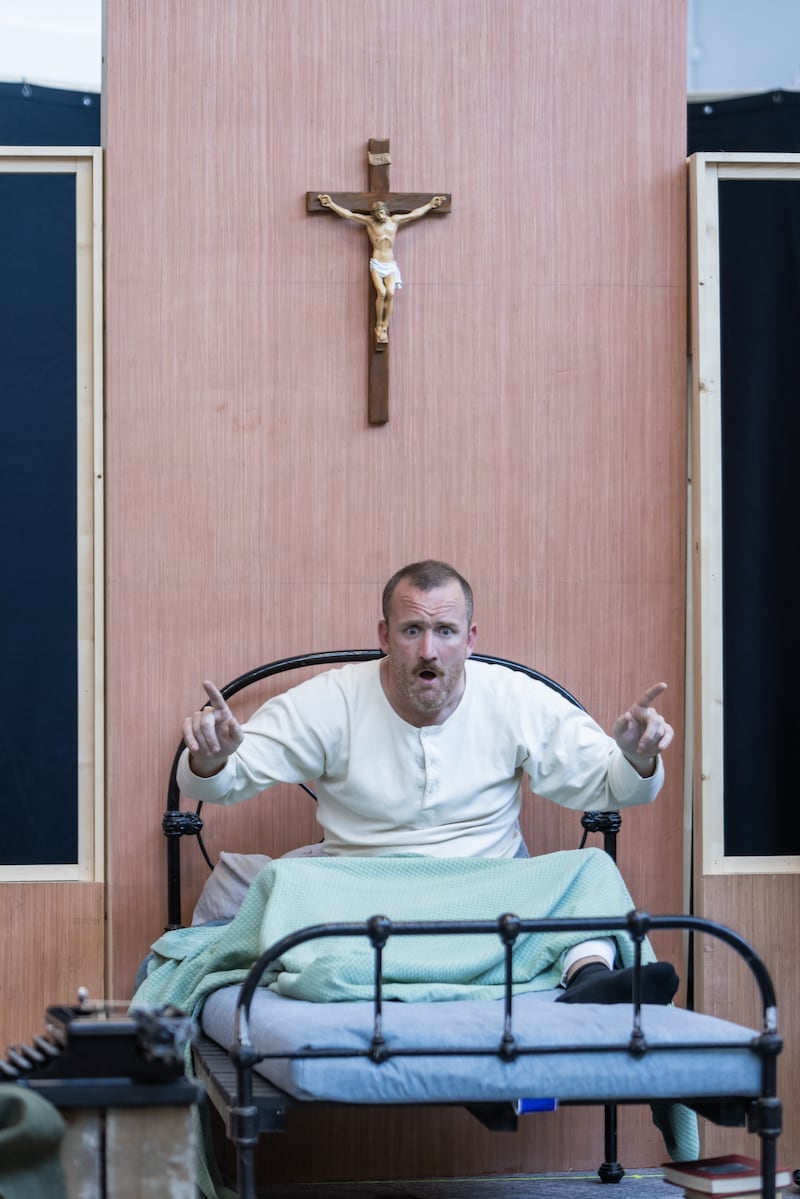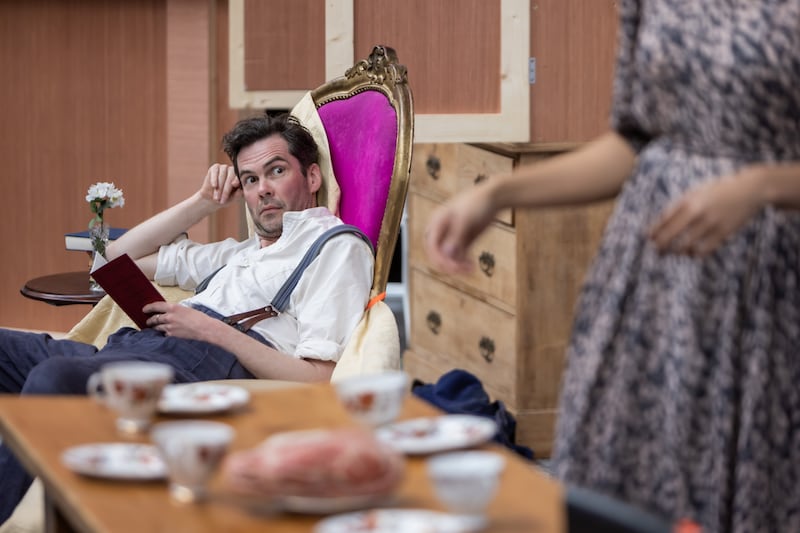The announcement in mid-March generated an instant gust of anticipation. Druid would stage the Seán O’Casey Dublin trilogy; arguably the company’s biggest undertaking since Garry Hynes’s lauded deep-dive of Druid Synge 18 years ago. A cast of 18 actors, including Druid ensemble players, and all three plays performed in a one-day trilogy; tickets, on sale later that month, flew. What has been happening in the meantime has involved the daily assembly of the nuts and bolts of the magic that Druid audiences associate with the company’s work.
On a sweltering noontime in Dublin the cast are pausing towards the close of the first act of Shadow of a Gunman to run through the technical details of how they respond to word – delivered from the street – of the death of Mr Maguire. Actors Marty Rea, Caitríona Ennis, Bosco Hogan, Catherine Walsh, Anna Healy, and Robbie O’Connor have to respond to the news in a way that enables all bar Ennis’s Minnie and Rea’s Donal to convincingly exit the tenement room. Hynes sits and watches as they run through and abandon several set-ups before swiftly settling on a sort of physical relayed formation that conveys the confusion and shock – and fast acceptance – at the bleak news. They are working out of the rehearsal room in the Digital Hub. The set is basic and the cast is wearing rehearsal costumes.
“That’s experienced actors on the stage knowing what we want to achieve and having seen it before,” Hogan will say later, sitting in the Mediterranean heat during the break for lunch. There is, of course, no guarantee that the agreed formation will make the staged production. Hogan plays James Gallagher in Shadow and Uncle Peter in The Plough and the Stars. “Two auld codgers,” he laughs. Hogan featured in Druid’s last play-cycle on Shakespeare eight years ago but his involvement with the work of O’Casey has been peripheral. He is delighted to be working again with Hynes, who first directed him “a very, very long time ago” for a production of Tom Murphy’s Famine at the Abbey.
“And I just didn’t get on to her wavelength then,” he says.
“And I felt quite frustrated by my inability to, to kind of really understand where she was coming from. Because to me at that point, I didn’t relish changing everything all the time coming in and saying, you know, we have this nailed down now. And then you come in tomorrow, and this has been unnailed in the meantime, and you put a new nail down something entirely different. I found that rather frustrating. But that was my failing. It has nothing to do with Garry, that was that was my inability to ... to go with the flow. The more than I’ve worked with her, the more the more I relish, that free-flowing search for what the solution is.”
One of the surviving clips of film featuring O’Casey is a wonderful, scratchy black and white few minutes of conversation with Barry Fitzgerald, who played Captain Boyle in the original Abbey production of Juno and the Paycock in 1924. The pair have been reunited in O’Casey’s home in Devon towards the end of the writer’s life. A white knit Aran sweater fills out his wiry frame. He wears his trademark coloured cap, is gaunt and energetic and speaks in a warm, lively voice.
O’Casey recalls the infamous night when the crowd at the Abbey Theatre began to riot during the performance of The Plough, provoking a thunderous rebuke from WB Yeats who, O’Casey tells us “came bounding out on the stage to oppose the howling mob. With his eyes flashing and his bushy hair waving like a bush that wasn’t burning. And his arms extending over the yellowing, bellowing dastards that tried to down the play and he shouting out of him, ‘You have disgraced yourselves again.’ And then when the roaring became worse and they shouted out against O’Casey he roared out at them with all the venom and vehemence that was in the great man, he shouted: ‘This is O’Casey’s apotheosis.’ Probably because he had some peculiar belief in the magic of a word. I wonder did those that were listening to him, Barry, understand what the meaning of a-po-theosis was. Did you? Of course, they didn’t. Well, neither did I.”
[ Druid to stage trilogy of Seán O’Casey plays in ‘mammoth’ productionOpens in new window ]
It’s a comical telling of one of the more infamous moments in Irish theatre, one that marked the high point of the Abbey’s fractured relationship with O’Casey. He left for London shortly afterwards and lived most of his life in England. Although O’Casey wrote 25 plays and a whopping six-volume autobiography, none of his later works received anything like the acclaim or theatrical endurance of the Dublin trilogy. When he submitted The Silver Tassie for consideration to the Abbey, he received a rejection letter from Yeats that was brutal in its candour and dismissiveness. (It was eventually staged by the Abbey in 1935, running for just five performances.)
A copy of the letter has been attached to the wall for the Druid rehearsals. It’s a pertinent reminder of the vital and complex place O’Casey commands in the Irish theatrical tradition. He’s an elusive character; his celebrated Dublin plays remaining popular, much of his other work neglected, while he is often portrayed as a prickly character and less graspable than Yeats.
I can’t act. And the most frightening place to me in the whole word is backstage at the side of the stage when there is a live performance going on
— Garry Hynes
“Which I think he was, you know,” says Hynes. “I know who I’d prefer to have a pint with, though. And it’s Seán O’Casey, every time.”
Staging these plays has been a long-held ambition of hers. If she could magic herself to any theatrical performance, anywhere, anytime, then she could not overlook those fractious nights at the Abbey when O’Casey’s plays were first performed. “I’d really, really love to have seen what those plays were like,” she says.
Part of the attraction for Hynes, aside from the hypnotic power of the Dublin trilogy, lies in capturing the unique influences that shaped O’Casey’s vision and sound.

“He is really odd in terms of how he emerged. Because he was very much influenced in a sense by amateur theatre and by popular theatre, such as Boucicault. In fact, he actually played in a Boucicault amateur production. And he created that in the Dublin plays, and then in later plays as well, this kind of mixture of Victorian melodrama, and sort of Ibsen-Shaw. And it’s this funny old mix that I don’t know any other major writer does. And because the plays deal with the tenements, poverty and poor people and, unfortunately, the problems we are still deep dealing with – hunger, housing, health – they were called for decades these great, naturalistic plays. They are not naturalistic in the least, I believe. They are so affected by performance – and performance as it was understood in the musical hall. Heightened. And some of the comic routines you could see us developing today are done to deliberately look like that. Whether people agree with that or not. They are not quite like anything else.”
She is chatting over what ought to be a break between rehearsing the first and second act. After the cast broke, she continued to jot a few notes down and read the paper for a little while. Days like this, deep in the well of rehearsals tend to fly by. They are, Hynes says, energising rather than sapping. Constructing the minute-by-minute development of each act is an exercise in patience. Before lunch Ennis and Rea were in the rehearsal room, finessing a scene where Minnie instructs Donal to type their names into the typewriter, holding him spellbound as he clicks on each key and afterwards, as she repeats their names, reading from the typed page. This occurs just minutes after the rambunctious exit of the others. And even in the dead noontime heat, with the sunlight infiltrating, the two actors create an extraordinarily charged and stilled atmosphere so that the outside world – both the war-torn Dublin that the characters inhabit and the pulsing metropolis outside – falls away.
Great writing gives you so much of the information that you can then run away with your imagination
— Gabriel Adewusi
They go through the scene several times, working out where best to stand; when to sit on the bed, how to look and generate the same energy every time. Hynes says little throughout, smiling and offering the occasional prompt and suggestion when asked by the actors. Part of the privilege of her work over the past four decades has been to direct great acting. No matter how close she gets to the art, she agrees its magic is impenetrable.
“It is mysterious. I can’t act. And the most frightening place to me in the whole word is backstage at the side of the stage when there is a live performance going on. You do marvel at what they can do. And you are surprised by it, constantly.”
O’Casey wrote his trilogy in 1923-1926, covering the Rising and Wars of Independence in the fledgling years of the Irish State. The cultural make-up of Ireland was monoethnic. This Druid production will feature a diverse cast, reflecting the change within Ireland since she first established the company with Marie Mullen and Mick Lally.
“I don’t think it’s irrelevant. I mean, people do see certain skin colour. When Druid started in 1975 the culture here was almost entirely white. It isn’t any more. And the theatre is about nothing else if not about the present day. So, it wouldn’t make any sense if the casting of theatre people and theatre generally didn’t reflect the people who are living here. There are Irish actors of colour making their living in this country. And in the sense that they enrich both our society and our way of looking at our society, it’s good for us.”
Gabriel Adewusi moved to Ireland with his family at the age of eight and “grew up in a bunch of places but mostly Dublin”. After he started college he trained at the Gaiety School and Bow Street Academy. He has roles in all three plays.

“It is a muscle that is in there, but also it’s muscle that is kind of in the rehearsal process,” he says, when he arrives for the afternoon rehearsal. “Of learning about the characters, understanding the characters, understanding how they relate to you understanding the place they have in the story. Because O’Casey is masterful at characters. It’s almost no work. I mean, that’s a bit of an exaggeration. It, you know, there’s always something in there to find, right?
“But O’Casey makes it easy for you to find those things that make the character different. He’s great at writing these colourful characters with distinct motives, across the story, but also, you know, in every kind of scene that they’re in. And when that foundation is in place, it’s just so much easier to do the work. The less acting, quote unquote, that you have to do the better, and great writing gives you so much of the information that you can then run away with your imagination. The actual practicality of it: that’s just fun.”
Before rehearsals began Clíodhna Hallissey spent days scrolling through archival newspaper photographs to take notes on contemporary costumes. The tenements life that O’Casey dramatises is like a microcosm of Dublin’s early 20th century class system. The fascination, for her, lay in arriving at what feels like the right combination for a given character.
The Abbey and O’Casey were really good for each other. O’Casey really did save that theatre
— Garry Hynes
“In Plough, when they loot and Juno when they get things: how new were those things that they got? Because there were a lot of pawn shops and a lot of stalls. Juno, as the matriarch, she will be the last person she spends money on. And her personal style doesn’t change as fast as fashion does. So, for Maisie Madigan, someone gave us a Victorian skirt with all this quilting. For us, it is beautiful because it has this lovely breakdown. It is the 1920s. Why would she wear a Victorian skirt? Well, why wouldn’t she?”
Hallissey has been with Druid since she applied for the Marie Mullen bursary. In 2015, while studying English and drama in Galway, she went to see Druid Shakespeare with her father. A five-hour chunk of the Bard felt like a daunting prospect. She left the theatre having been splashed with mud and hit by raindrops created for the production and convinced this was what she wanted to do. Now she is planning costumes for the next mammoth production.
“If you enjoy character and delving into character analysis, costume is just the external skin of that. That is what costume is: you are creating the visual skin of that character and there is nothing more satisfying than [an] actor stepping into a costume and saying, oh yeah, this feels like him or her.’
That streak of energy has been a vital element of Druid’s success over the past four decades. You don’t have to spend long with the company to sense a collective goodwill and excitement at work. When Hynes reflects on the fearless naivete with which Druid was founded, she thinks that despite the glittering run of accolades and successes, keeping the ship afloat is more difficult now than then. She laughs at herself for having the gall to front what they called a professional theatre company “even though you’ve probably never seen a professional play in your life”. But so what? Had they failed then, “you go off and do something else or whatever”. Now a Druid performance will inevitably bear comparison to the company’s previous successes and interpretations. “A highlight not just of my theatre-going year, but of my theatre-going life,” was how Charles Isherwood summarised the DruidSynge experience in the New York Times in his annual review in Christmas 2006.
Druid and Hynes – the first woman to win a Tony for Best Direction of a Play (Martin McDonagh’s Beauty Queen of Leenane in 1998) – are regarded as national treasures. But she can’t disguise her frustration at the cavalier treatment of the Irish theatrical tradition, resisting the suggestion that it has a heavyweight international reputation.
“I don’t know if it does, I mean, I think that would need to be tested. I think individual actors – you know it is extraordinary that you go from people like Saoirse Ronan, Paul Mescal, Cillian Murphy. There’s great richness in that, but in terms of our influence, or our existence on major stages in say, London or New York, I don’t think it does, you know? I think, clearly, it does happen from time to time. But it’s still a fairly small business we operate. For instance, I’ve been incredibly fortunate. And it’s incredibly rare in the sense that almost all my life I’ve been, in effect, paid a salary rather than being a freelance director, out shopping for jobs. And I absolutely know that I would not be a theatre director now, had I been freelance. I would not. Because first of all, I definitely would not have gotten the work to make theatre almost solely here in this country, I would have to become London or New York based. And indeed, I almost did. And so, I just wouldn’t exist in the same way. Except I’ve been just this really rare thing that I’ve worked with Druid and worked with the Abbey and spend one or two years as a freelance.
“But the arts are still shockingly underfunded here. I don’t think at a real serious level it is thought important enough. They are lovely and it is nice and isn’t what they do great. But it is not real. And that is the reality we all have to face. Because we all live in our bubbles where we are treated as if we are important. But if you look at the percentage of the national budget that is spent on theatre, it is ludicrous.”

Those frustrations fall away when the cast returns to the stage. It is a sort of homecoming, this. A century after those volatile productions, the Abbey will stage the Druid production in August: the theatre’s website promises that through Hynes’ vision, the audience will experience O’Casey’s work as never before.
“The Abbey and O’Casey were really good for each other,” she says, quietly.
“O’Casey really did save that theatre. And the fact then that, officially, the relationship didn’t flourish ... I mean, one of the things, for instance, that the Abbey has done very well in modern times, has been to produce writers. Like, for instance, Friel or Tom Murphy, on a continuing basis, they would stage a masterpiece like Translations or any of Murphy’s plays; the next play would not necessarily be beyond the achievement of the previous but the Abbey would continue to stage their new plays. Which seems to me to be absolutely right. And absolutely what a theatre called a national theatre which looks for a life longer than one production must do, should do. And, of course, O’Casey didn’t have that. And so therefore, his plays were produced in London and elsewhere, where the actors available were English actors, but they were from a different culture. You can’t be involved in theatre to the degree I am and not think that’s sad.”
DruidO’Casey is at the Town Hall Theatre as part of Galway International Arts Festival on July 9th-30th; Lyric Theatre, Belfast, August 5th-19th; Abbey Theatre, Dublin, August 26th-September 16th












